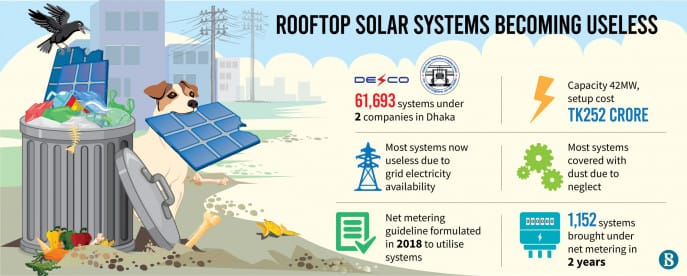Building owners set up solar systems as a demo to get grid electricity connection and lost interest in them as power supply improved
Eyamin Sajid: In 2014, power outages were almost a commonplace of city life and rooftop solar systems were a prerequisite for getting grid power connection.
So, owners of Bailey Ballerina, a residential facility on New Bailey Road in the capital, had to install a solar power system on the rooftop spending around Tk2.5 lakh.
But the installation, comprising 49 panels with a capacity of 4.11 kilowatts, now lies useless.
“Electricity supply from the grid has improved a lot. Besides, the building has backup generator support in case of load shedding. So, the rooftop solar system has lost its usefulness,” says Moazzem Hossain, general secretary of the Flat Owners’ Association of Bailey Ballerina.
Most solar systems installed in Dhaka and other divisional areas are now hardly of any use.
Currently, there are around 61,693 rooftop solar systems with a capacity to generate 42 megawatts of electricity under two power distribution companies in Dhaka. Set up at a cost of around Tk252 crore, they have now just become e-waste and a waste of money, too.
According to the Bangladesh Solar and Renewable Energy Association, per megawatt rooftop solar power generation costs Tk6 crore. This cost includes cost of land, installation of the solar power system and continued maintenance.
A recent survey by the Dhaka Electric Supply Company Limited (Desco) in Gazipur’s Tongi found that around 90% rooftop solar systems there were non-functional.
The study titled “Effectiveness of net metering system in Dhaka city for rooftop PV system” observed 35 rooftops and found that only three to four facilities were in use properly.
Desco executive engineer (planning and design division) Engr Md Raihan Mondol told TBS that building owners set up solar systems as a demo to get grid electricity connection.
They abandoned the systems once they got grid power connection, he said.
“We found that rooftop solar panels were non-functional or connected to faulty inverters. The panels were covered with dust,” he added.
Meanwhile, Chowdhury Md Shahriar Ahmed, assistant professor and director at the Centre for Energy Research (CER) at United International University, told TBS that making it mandatory to install rooftop solar power systems in urban areas was not a wise decision.
The accumulator batteries of solar power systems lose charge after a few days and become non-functional. Users are uninterested in maintaining the system as they find these useless, he added.
Grid system improves in past few years
In 2010, rooftop solar power systems were made mandatory for getting new domestic, industrial and commercial electricity connections from the grid system, to boost the share of renewable energy in the country’s total energy mix.
As per the existing guidelines, household customers need to have at least 3% of solar power generation capacity against their total demand, while it is 10% for industries and commercial consumers whose demand exceeds 50 kilowatts.
Currently, there are 24,693 rooftop solar power systems in Desco areas while the Dhaka Power Distribution Company (DPDC) has some 37,000 facilities in its franchise areas, including Dhaka South and Narayanganj city corporations.
The Bangladesh Rural Electrification Board, the country’s largest electricity distribution company, also has lots of rooftop solar systems at divisional and district levels.
However, the systems have now become superfluous as the grid electricity system saw gradual improvements in the last couple of years.
Dr Saiful Huque, professor and director of the Institute of Energy under the University of Dhaka, told TBS that investment in rooftop solar systems has become a waste owing to available electricity supply in on-grid areas.
“These systems have become useless and idle as people are getting the required electricity from the grid distribution system,” he said.
“Apart from this, most panels were not installed properly. Owners are not interested in maintaining them as they are not facing power shortage nowadays,” he observed.
The professor opined that the country could produce a good amount of renewable energy if rooftop solar systems were properly managed.
“To that end, the systems should be inspected by a third party regularly instead of power distribution companies,” Saiful said.
However, distribution companies claim that they are monitoring the panels regularly regardless of whether those are functioning properly or not.
Engineer Bikash Dewan, managing director of the DPDC, told TBS, “We issued a directive for each DPDC customer service point to check rooftop solar systems. We also discussed the condition of the systems in our monthly coordination meeting.”
Mohammad Hossain, director general of Power Cell, a technical arm of the Power Division, said they had introduced the rooftop model to meet the country’s renewable energy use target.
But sadly, people did not take it seriously, he said.
“However, we have started the net metering initiative so that we can ensure proper use of the infrastructure,” Hossain added.
Net metering, a possible solution?
At the end of 2018, the Power Division came up with a “Net metering guideline” for proper utilisation of rooftop solar systems.
Net metering system allows solar panels to be connected to the distribution grid. Excess electricity is transmitted to the grid and consumers can use energy when it is necessary for them. A two-way metering system keeps track of the power flow in two directions–from solar panel to the grid and from the grid to the home. Monthly electricity bills are adjusted on the power transmission and usage.
It became a blessing for rooftop solar system owners as it gave them an opportunity to earn money by selling power to the distribution grid.
However, the initiative saw slow progress due to some complexities and problems, including poor financial viability of connecting rooftop solar systems to the grid.
As a result, after two years, only 1,152 rooftop solar facilities were brought under the net metering system under six power distribution companies across the country.
Due to this limitation, electricity suppliers are not that interested in bringing rooftop solar systems under net metering, said sources at the DPDC and Desco.
Former member of Sustainable and Renewable Energy Development Authority (Sreda) Siddique Zobair said solar panels with low capacity that are not financially viable can be connected to the grid under a cluster system.
He also said 90% of the panels remain idle not only because of availability of grid power but also people do not have enough information about the net metering system.

